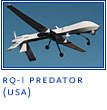
|

|
With their strange silhouettes and awe-inspiring capabilities,
today's unmanned aerial vehicles, like this Predator, seem to
have flown in from the future. But the Predator and the dozen
other operational UAVs in the U.S. military arsenal are only
the most recent and advanced installments in a century-old
history of unmanned warfare and surveillance from the skies.
Here, get to know 21 UAVs from the Civil War to the present,
and beyond.—Lexi Krock
|

|

|

|

|

|

|

|

|

|

|
Years before the first manned airplane flight on December 17,
1903, primitive UAV technology was used for combat and
surveillance in at least two wars.
View UAVs
|

|

|

|

|
During World War I, the first UAVs took flight in the U.S.
Though the success of UAVs in test flights was erratic, the
military recognized their potential in combat. Armistice
arrived before the prototype UAVs could be deployed in
earnest.
View UAVs
|

|

|

|

|
For more than a decade after the end of World War I,
development of pilotless aircraft in the U.S. and abroad
declined sharply. By the mid-to-late 1930s, new UAVs emerged
as an important combat training tool.
View UAVs
|

|

|

|

|
During World War II, Nazi Germany's innovative V-1
demonstrated the formidable threat a UAV could pose in combat.
America's attempts to eliminate the V-1 laid the groundwork
for post-war UAV programs in the U.S.
View UAVs
|

|

|

|

|
From their early use as target drones and remotely piloted
combat vehicles, UAVs took on a new role during the Vietnam
War: stealth surveillance.
View UAVs
|

|

|

|

|
The success of the Firebee continued through the end of the
Vietnam War. In the 1970s, while other countries began to
develop their own advanced UAV systems, the U.S. set its
sights on other kinds of UAVs.
View UAVs
|

|

|

|

|
During the late 1970s and throughout the 1980s, the Israeli
Air Force, an aggressive UAV developer, pioneered several
important new UAVs, versions of which were integrated into the
UAV fleets of many other countries, including the U.S.
View UAVs
|

|

|

|

|
UAVs command a permanent and critical position in high-tech
military arsenals today, from the U.S. and Europe to Asia and
the Middle East. They also play peaceful roles as monitors of
our Earth's environment.
View UAVs
|

|

|

|

|
The surveillance UAVs of tomorrow may evolve into MAVs, or
micro aerial vehicles, lilliputian spies so tiny they can take
off and land in the palm of their operators' hands. The U.S.,
Great Britain, Korea, and Israel are developing MAVs for
surveillance use in the future.
View UAVs
|

|

|
This feature originally appeared in a slightly different form on
NOVA's Spies That Fly Web site.
|
|

